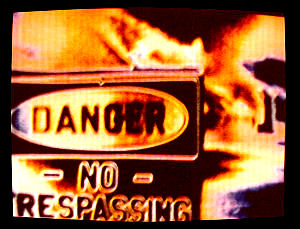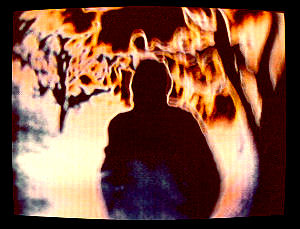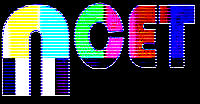 |
Continued: I had played no part whatsoever in the earlier exploits of NCET. When I came on staff, work was already under way on Brice Howard's production entitled (I think) “Mother Goose,” and as soon as I walked in, I was asked to run the smallest color television camera I had ever seen, much less operated. I didn’t know the equipment, or anything about what they were trying to do with it. Aside from about a 10 minute philosophical introduction from Brice, I had no prep whatsoever, so I just ad-libbed. Here we all were in a studio fairly littered with equipment and wires, a dancer (John Graham), a graphic artist (Bill Roarty), a design professor and - in this case - light sculptor (Willard Rosenquist), a composer (Richard Felciano), someone operating a clearly home-built mixing console ( Bill Gwin studiously absorbed with the first stage of what eventually became known as the ‘Templeton Mixer’ - after Larry Templeton), and a broadcast TV producer-director (me), simultaneously attempting just about anything that came to mind. Meanwhile Brice narrated from his rather rambling and expressionistic poem of the same name. The result of all this was simply being recorded on tape after tape.
Ultimately “Mother goose” never ‘flew.’ In my estimation “Mother Goose” was far too complicated an effort to be so loosely handled with such primitive equipment. One could compare this approach with trying to make gelatin, in the wrong sized container, and without measuring an excess of water working its way into the recipe, so that it never really 'gels.'
Then again, to use an illustration from television itself, Brice was a producer but seemed unwilling to be a director. The job of a producer is to provide an idea, and a well protected and properly supplied environment, while the job of the director is to ‘captain’ the army in doing tactical battle with the restrictions, limitations and shortcomings of the medium (or, in this case, media). Hopefully everyone emerges victorious, with the idea well intact. Brice had provided the environment, but his vision was to do away with all limitation if possible. Unfortunately, this isn’t very workable in any medium - and particularly in video - which, being frightfully technical, is rife with inherent limitations (even improvisational jazz has underlying structure which must be adhered to). In the end, the total output was so unwieldy that, in all probability, no one could have organized all that diverse and meandering material into a viable product. “Mother Goose” was never completed, but my job continued as an earnest search for a job description.
The “Mother Goose” production went on literally for weeks, and only over time I found out that, aside from running that camera, the production manager, so-called, was responsible for the equipment hook-ups (which were quite elaborate and highly unconventional – and which also seemed to need to be largely re-thought and re-worked about every hour). My further duties included making sure that all this rather cranky equipment was sufficiently maintained by our engineer.
None of the artistic staff, I discovered, really knew very much about how the equipment operated. They just trusted that it would – and were frequently disappointed. I had learned through years of broadcast work, where I often crossed union lines (thereby becoming fairly familiar with the technical side of the business), that one is foolish ever to be too trusting of electronic equipment. It appears that my fortuitous arrival at the center was actually an event critical not only to the progress of production on “Mother Goose,” but to the center’s operation in general. The production manager, I eventually realized, was brought in to ‘tame the beast,’ which was badly out of control, and to bring it, as rapidly as possible at least, to a condition of minimal predictability. So, training staff and standardizing equipment configurations is what I did for my first few months with NCET. In the long run, I did manage to instill a practical degree of order into much of the way the facility functioned, and the improvement was generally well received, as it was noticeably easier for the artists to accomplish their visions.
It was during this period that I was introduced to four people who became very important to my life. Paul Kaufman who, I think, had inherited the job of Executive Director from Brice. Paul seemed to be in charge, now, of the budget, and fund-raising. It was from Paul that I (we) began to hear about 'completed works.' Paul was strongly of the opinion that we had to come up with video pieces that could be exhibited publicly, and to funding sources, to justify our existence. This concept, which I think may have been somewhat at odds with Brice’s philosophy, became an increasingly important influencing factor at the center.
And then there was Anna Turner who was the Director of Information, tape librarian and administrative assistant to both Brice and Paul. She was, therefore, very central to the entire operation. She and I became very close very quickly, fell in love, and were ‘an item’ for much of the Center’s life. Anna was sweet, beautiful, skillful, intelligent, insightful, and in our work situations, astoundingly dependable. She was an artistic sounding-board for me, and we worked very closely together on most of my more demanding projects – including being my primary support person throughout the production of the Videola exhibit.
Bill Roarty had a mind equally as strange as mine, so we hit it off very quickly. Our mutual understanding was uncommonly deep. He’s a lovely man, and a very shy soul, but extremely bright and creative. We only made “Untitled” together, I believe, though, feet up on the nearest support, we brainstormed, reflected and philosophized at great length on much in art and life in general.
The fourth was Rick Davis, whom I hired to replace Bernie Stauffer as maintenance engineer. He had just returned from a road tour with the “Doobie Brothers,” worked at Wally Heider’s recording studio, and was designing a very sophisticated audio console for Neil Young. We hit it off immediately, and Rick has been possibly my best friend ever since. Rick and I collaborated on much video work late into the night (though I’m afraid little survives today). He did work with me on the “Father Tapes,” and he created the wonderful sound track for “Suite for Paul.”
It appeared clear to me that one of the reasons the Center was having trouble coming up with 'completed works' was because things were a bit too ‘casual.’ Trustful, it was, and very family-like. But so trustful was it that nothing was ever written down, and all things were obviously up for change - if not every few minutes, then probably every day.
At the same time I had begun to experiment around with the facility after hours when everyone had gone home. (Actually there was a ‘day crew’ which consisted of the administrative folks like Paul, Brice, Rita, Anna, and some artists like the 2 Bills (Gwin and Roarty), and Willard. Then there was a night and weekend crew who used those hours because all was quiet and one could concentrate. This bunch was made up mostly of the composers: Richard Felciano and Warner Jepson. Stephen Beck and I seemed to be denizens of both crews.
I pretty much had the place to myself and I began to make my own video pieces. Probably due to my broadcast experience and greater control of the gear, my work had a ‘beginning, middle and end.’ That was what Paul defined as ‘completed work.’ It was natural to me, and apparently what Paul was looking for. Not to be critical, but the others had not had the kind of experience that broadcast work entails, and weren't so clear on how to shape their output so that it could be shown as a ‘completed work.’ They appeared to be involved in endless ‘sketching,’ as Brice encouraged them to do. So their work was almost all open-ended, and recorded just that way. Though, in all fairness, Brice’s use of the term ‘sketching,’ as well as the earlier works that the Center produced under his guidance, does suggest that it would all, eventually, result in finished pieces of video art.
The first two pieces I showed to the staff were “Kiss With No Up” and “Blind Shaman.”
| |
 |
|
 |
|
| |
Blind Shaman - Danger |
|
Bill Roarty as the Blind Shaman |
|
| |
|
|
They met with much approval, especially from Paul, who exclaimed, “That’s what I mean. That’s completed work.” For some unexplained reason, Brice just silently left the room. It may have been because “Kiss...,” if you look carefully, shows Anna turner and me kissing very intimately while on Marin beach, and one image could easily have been mistaken for a breast. Actually, the piece was edited in the camera (a frequent practice of mine), and I was holding the camera in one hand or the other while shooting Anna and myself from various angles in mid-kiss – hence the title (the ‘maybe breast’ was actually Anna’s chin from below, and we had actually gone no farther than kissing). Under any circumstances, about two weeks later, Brice asked to meet with me and suggested that I become one of the artists-in-residence. I didn’t of course refuse, as I was beginning to get an appetite for the unprecedented (to me) freedom of this kind of work/play in a medium I was so familiar with. And that’s how my status at the center changed permanently.
We were at the Bryant Street studio for maybe a year more (memory is unclear on this), but Marvin Duckler, a former CBS lighting director, was brought in as the new production manager, and we moved to the Folsom Street building in very close succession. I was already working on the Videola at this time. Paul Kaufman was very turned on by the small prototype I had made (below with Anna), which could only be viewed by one person at a time.
When he asked me if I could make one large enough to view by significant groups of people in a museum setting, and I replied that I thought I could, he asked me to specialize on the project.
I didn’t actually begin to design the large Videola until we had completed the move to Folsom Street.
I continued to work on the Videola and, on viewing larger prototypes, the San Francisco Museum of Modern Art curators committed to a 6 week solo exhibit in late1972.
[A little more about the Videola: Previous to the Videola (created in 1971), no one had devised a way to escape the tyranny of the rather small standard television screen as a space in which to create or display video art - especially to a large number of spectators. The use of multiple monitors formed a common attempt to cope with this limitation, but that option really didn't accomplish the desired objective. So, in it's day at least, a kaliedoscopically generated spherical surface measuring 6 feet in diameter, and viewable by up to 100 persons at a time, was an entirely radical departure as a video artist's canvass.]
Wamt to make your own Videola? All You Need To Know To Build A Videola (Adobe Acrobat file)
The artists at the Center did move during this time toward smaller collaborations which made the artistic output more manageable. People found others they especially liked to work with. For instance, Bill Roarty and I made “Untitled” together. Bill Gwin and Warner Jepson produced “Irving Bridge.” Stephen Beck and I collaborated on two hours of the total of six taped hours that comprised the Videola exhibit, and we did live Videola concerts together at Folsom street, and at the museum (Stephen doing video and I, sound). Individual creation became more common, and the output of “completed works” much more plentiful. NCET was indeed becoming a different place.
~~~~~
Below is a listing of my work at NCET:
| |
PIECES FOR STANDARD SCREEN
Adagio for Spheres (with Rick Davis)
33
Ball
Blind Shaman
Chinese Wolf (with Bill Roarty)
Control Points
Down By the River (Neil Young tape)
Girl in Two Formats
Good Time Charlie Mars
Kiss With no Up
Images of Perfection: Suite for Paul
(Sound design by Rick Davis)
The Father Tapes
Untitled (with Bill Roarty)
Verlaine Trilogy
Winter Wisdom |
|
| |
|
|
|
 |

